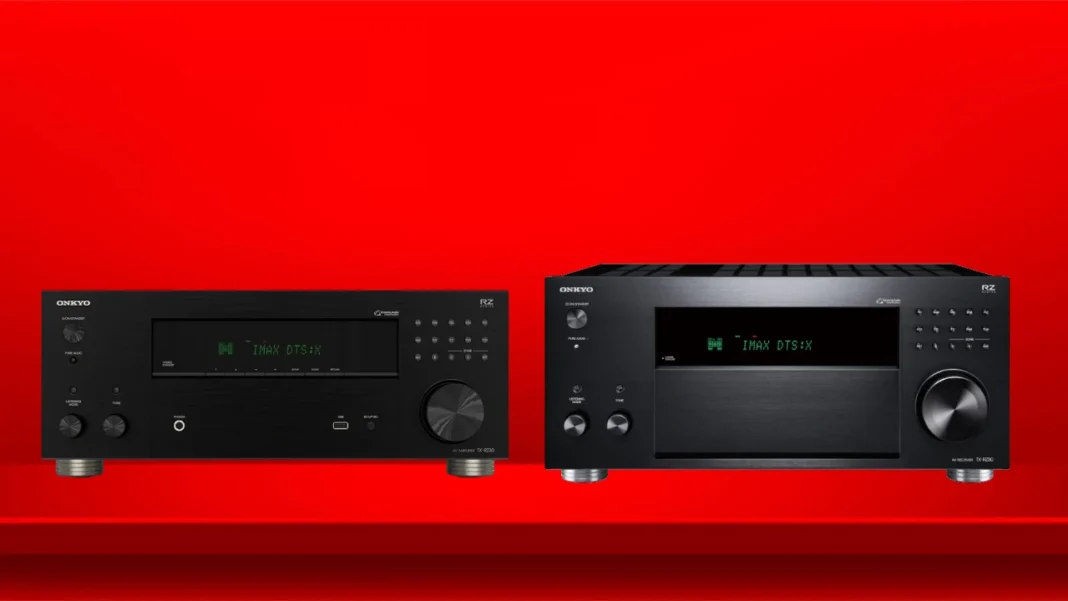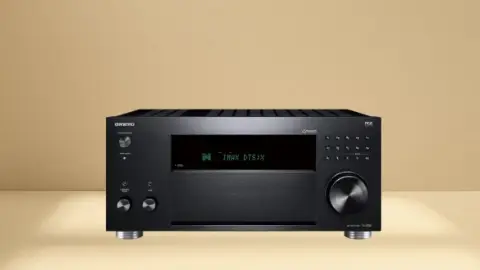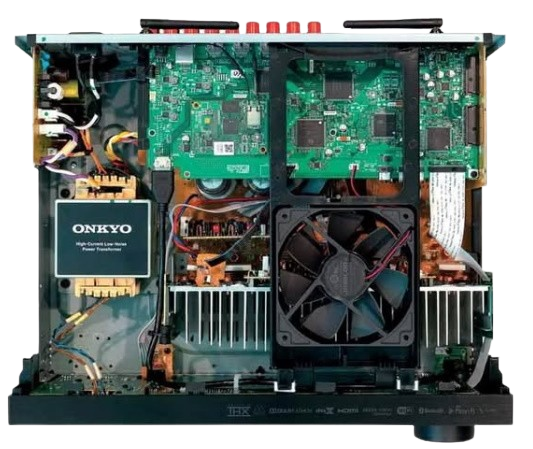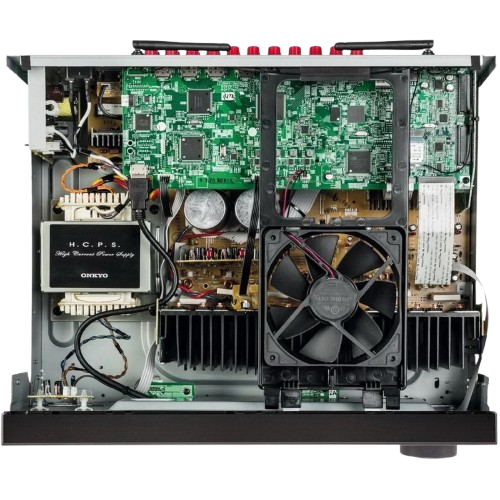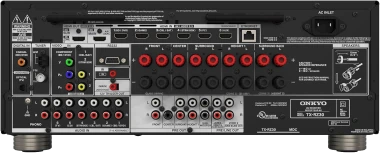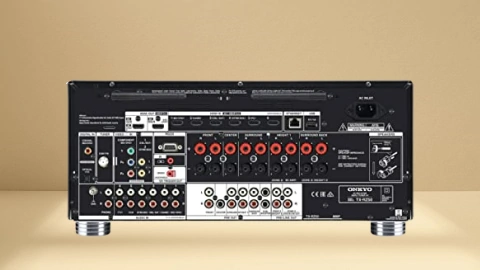Amplifier & Power Output
The TX-RZ30 and TX-RZ50 both feature 9.2 channels, meaning they support up to 9 speakers and 2 subwoofers. This allows for an immersive surround sound setup, including Dolby Atmos and DTS:X configurations.
- TX-RZ30: 100 W per channel (8 Ohms, 20 Hz – 20 kHz, 0.08% THD)
- TX-RZ50: 120 W per channel (8 Ohms, 20 Hz – 20 kHz, 0.08% THD)
The TX-RZ50 provides slightly more power, which can lead to better dynamic range and sound clarity at higher volumes, making it more suitable for larger rooms or more demanding speakers.
Audio Processing & Surround Sound Technologies
Both receivers support Dolby Atmos and DTS:X, two of the most advanced surround sound formats available today. These formats create a 3D sound environment, enhancing movies and games by allowing sounds to come from all directions.
- TX-RZ30: Supports DTS Neural:X, DTS:X, IMAX Enhanced, Dolby Atmos, and Dolby Surround
- TX-RZ50: Supports DTS:X, IMAX Enhanced, and Dolby Atmos
A key difference is that the TX-RZ30 also includes DTS Neural:X and Dolby Surround upmixing, which enhance older audio formats by simulating immersive surround sound.
Neither model supports Auro-3D, another immersive audio format.
Video & HDR Support
Both receivers support 8K video passthrough, which means they can handle the latest high-resolution content without downscaling. However, there are slight differences in HDR (High Dynamic Range) support:
- TX-RZ30: Supports HDR10+ and Dolby Vision
- TX-RZ50: Supports HDR10, HDR10+, Dolby Vision, and Hybrid Log Gamma (HLG)
The TX-RZ50 has broader HDR support, adding Hybrid Log Gamma (HLG), a format used in some live TV broadcasts.
Connectivity – Inputs & Outputs
Both receivers have extensive input/output options, but there are a few key differences.
HDMI Inputs & Outputs
- TX-RZ30: 6 HDMI inputs (HDMI 2.1), 1 HDMI output, 1 HDMI Sub/Zone 2 output
- TX-RZ50: 6 HDMI inputs, 1 HDMI output, 1 HDMI Zone 2 output
The TX-RZ30 exclusively features HDMI 2.1 inputs, which support higher bandwidth and advanced gaming features like 4K/120Hz and 8K/60Hz.
Analog & Digital Inputs
- TX-RZ30: 1 RCA Component, 2 RCA Composite, 1 Optical, 1 Coaxial, 6 Stereo RCA, Phono (Turntable) input
- TX-RZ50: 1 RCA Component, 2 RCA Composite, 1 Optical, 1 Coaxial, 6 Stereo RCA, Phono (Turntable) input
Both receivers have nearly identical analog and digital inputs.
Pre-Outs & Subwoofer Outputs
- TX-RZ30: 3 Stereo RCA Pre-Outs, 2 Subwoofer Pre-Outs
- TX-RZ50: 1x 11-Channel RCA Pre-Out, 2 Subwoofer Pre-Outs
The TX-RZ50 has an 11-channel pre-out, allowing users to expand the system with additional external amplifiers for better performance.
Wireless Connectivity & Smart Features
Both models support wireless connectivity, but the TX-RZ50 offers more features.
- TX-RZ30: Supports AirPlay 2, Roon Ready
- TX-RZ50: Supports Wi-Fi 5, Bluetooth (AAC, aptX, aptX HD, SBC)
The TX-RZ50 also includes Bluetooth with aptX HD, ensuring higher-quality wireless audio.
Smart Assistant Integration
- TX-RZ30: Works with Google Assistant, Siri
- TX-RZ50: Works with Alexa, Google Assistant, Apple AirPlay
The TX-RZ50 has broader smart home compatibility, including Alexa support.
Mobile App Support
- TX-RZ30: No mobile app support
- TX-RZ50: Supports Onkyo Music Control app (Android & iOS)
The TX-RZ50 allows for easier control via a smartphone app, making adjustments more convenient.
Power Consumption & Efficiency
- TX-RZ30: 750 W (Active), 2 W (Standby)
- TX-RZ50: 850 W (Maximum), 75 W (Active), 0.1 W (Standby)
The TX-RZ50 is more energy-efficient in standby mode, consuming only 0.1 W compared to 2 W on the TX-RZ30.
Physical Dimensions & Weight
- TX-RZ30: 17.1 x 7.0 x 15.1 inches (435 x 177.5 x 382.5 mm), 25.4 lbs (11.5 kg)
- TX-RZ50: 17.1 x 7.9 x 15.7 inches (435 x 201.5 x 398.0 mm), 30.9 lbs (14 kg)
The TX-RZ50 is slightly larger and heavier, possibly due to additional components such as its higher power amplifier.
Final Thoughts – Which One is Better?
Choose the TX-RZ30 if:
✅ You want DTS Neural:X upmixing for legacy content
✅ You prefer a simpler setup without mobile app dependency
✅ You need full HDMI 2.1 support for gaming or future-proofing
Choose the TX-RZ50 if:
✅ You need more power (120 W per channel vs. 100 W)
✅ You want Hybrid Log Gamma (HLG) HDR support for live TV broadcasts
✅ You prefer built-in Bluetooth (aptX HD) and Wi-Fi
✅ You want smart home compatibility with Alexa
✅ You need an 11-channel pre-out for external amplifiers
Both receivers are high-end options, but the TX-RZ50 is slightly more advanced, making it ideal for users who want more power, expanded connectivity, and better integration with smart home systems. However, the TX-RZ30 is still a solid choice, particularly for gamers or those prioritizing HDMI 2.1 features.
